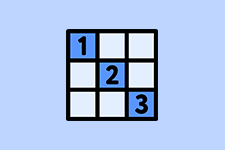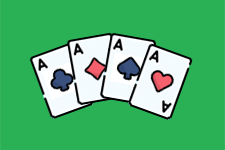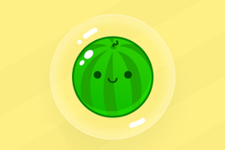Watermelon Game Free to Play Online – No Ads & No Downloads
The Watermelon Game is a delightful and relaxing fruit-merging puzzle where charming physics meets thoughtful strategy. It’s a game that’s easy to learn but offers a satisfying challenge as you try to create the biggest fruit of all—the watermelon. Here, you can enjoy the experience instantly in your browser with no ads and no downloads required.
This guide will walk you through everything you need to know, from the basic rules and scoring to advanced strategies that will help you master the art of fruit stacking. Ready to test your focus and planning skills?
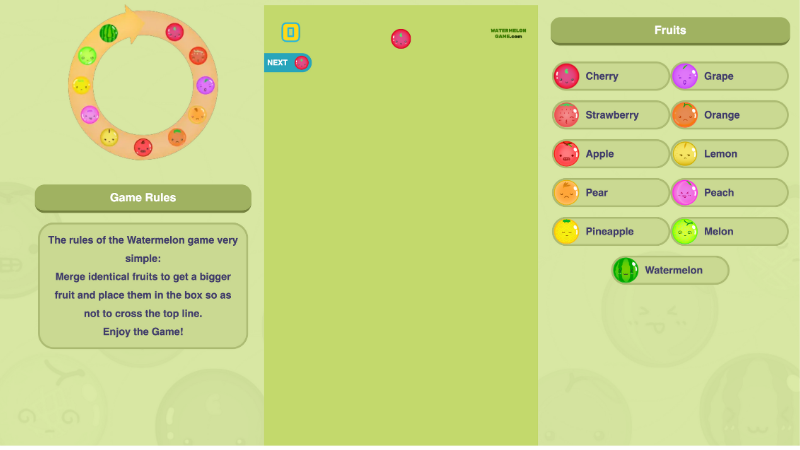
A bright, inviting image showing the Watermelon Game in mid-play. Various cute, cartoonish fruits like cherries, strawberries, and oranges are visible inside a clear container, with a large melon near the bottom. The background is a soft, pleasant color. | Alt Text: A gameplay screenshot of the Watermelon Game, showing a colorful assortment of fruits being merged inside a box.
What Is the Watermelon Game? (Overview & Origins)
The Watermelon Game, also widely known by its Japanese name “Suika Game,” is a single-player puzzle game that combines elements of dropping and merging puzzles. The core idea is simple: you drop various fruits into a container, and when two identical fruits touch, they merge to form a larger, different fruit. Your goal is to continue this process to create the largest fruit possible, the watermelon, and achieve a high score without letting the container overflow.
The game’s charm lies in its physics-based mechanics. Unlike static puzzle games, the fruits in the Watermelon Game are round and affected by gravity. They roll, bounce, and shift, meaning a single drop can cause a cascade of unexpected merges or completely disrupt your carefully laid plans. This element of unpredictability makes each session unique and engaging.
Originally developed in Japan by Aladdin X, the game was first released for the company’s digital projectors in 2021 before launching on the Nintendo eShop. It gained massive international popularity in late 2023, becoming a viral sensation thanks to streamers and content creators on platforms like Twitch and YouTube. Its concept was inspired by a Chinese browser game called “Synthetic Big Watermelon.”
For many players, the Watermelon Game feels like a gentle mix of Tetris and 2048, but with its own unique, physics-driven twist that rewards patience and spatial planning over quick reflexes.
| Feature |
Watermelon Game |
2048 |
Tetris |
| Core Mechanic |
Merging + Physics |
Merging |
Stacking & Clearing |
| Primary Skill |
Strategic Planning |
Logic & Foresight |
Reflexes & Speed |
| Pacing |
Calm, no time limit |
Methodical |
Fast-paced |
| Randomness |
High (physics) |
Low (tile placement) |
Medium (piece order) |
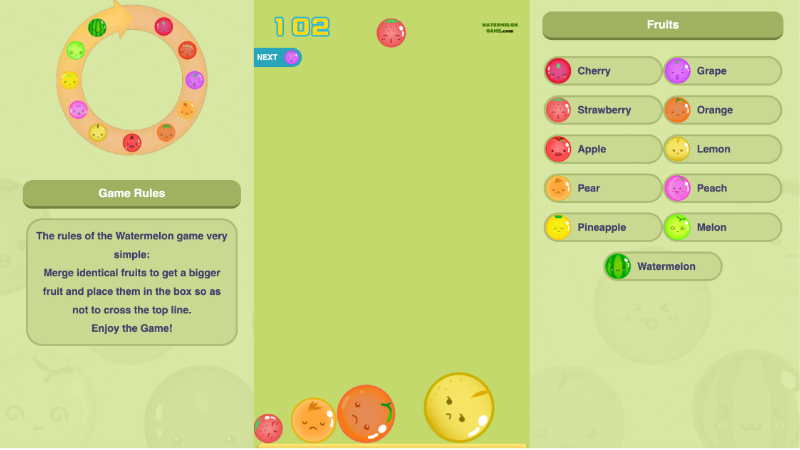
How to Play the Watermelon Game — Step-by-Step Guide
Understanding the fundamentals is the first step to becoming a fruit-merging master. This guide breaks down the objective, controls, scoring, and end-game conditions to get you started on the right foot.
Game Objective
The primary goal in the Watermelon Game is to merge identical fruits to create progressively larger ones, with the ultimate aim of forming a watermelon. Each merge increases your score, and the larger the fruits you combine, the more points you earn.
The game is designed as an endless-play challenge. There is no final “winning” screen; instead, the objective is to survive as long as possible and achieve the highest score you can before the fruit pile overflows. This focus on personal bests encourages patience, careful planning, and continuous improvement.
Basic Controls & Mechanics
The controls are incredibly straightforward:
- Move: Use your mouse or finger to move the fruit horizontally at the top of the screen.
- Drop: Click or release your touch to drop the fruit into the container.
The most crucial element is the game’s physics engine. Fruits are round and will roll, bounce, and settle based on how and where you drop them. A fruit dropped onto a sloped surface might roll into a perfect spot for a merge, while a poorly placed one could get wedged in an awkward position. Mastering the drop requires thinking ahead about how each fruit will interact with the others already in the container.
Scoring System Explained
Points are awarded for every successful merge. The value of a merge increases with the size of the fruit being created. For instance, merging two small cherries provides a small number of points, while merging two large pineapples to create a melon yields a much higher score.
This system rewards creating larger fruits, as the point bonuses grow exponentially. The key to a high score is to create chain reactions where one merge triggers several others in quick succession.
Here is the typical fruit hierarchy and the points awarded for each merge:
| Merge Creates |
Points Awarded |
| Strawberry |
1 |
| Grapes |
3 |
| Dekopon |
6 |
| Orange/Persimmon |
10 |
| Apple |
15 |
| Pear |
21 |
| Peach |
28 |
| Pineapple |
36 |
| Melon |
45 |
| Watermelon |
55 |
Note: Point values can vary slightly between different versions of the game.
Game Over Conditions
The game ends when the pile of fruit breaches the line at the top of the container. This can happen in two ways:
- Stacking Too High: The most common way to lose is by filling the container to the top.
- Bouncing Out: The pressure from a merge can sometimes launch a smaller fruit upwards, causing it to fly out of the box and end the game instantly.
When the game is over, your final score is displayed, and you are encouraged to try again to beat your personal best.
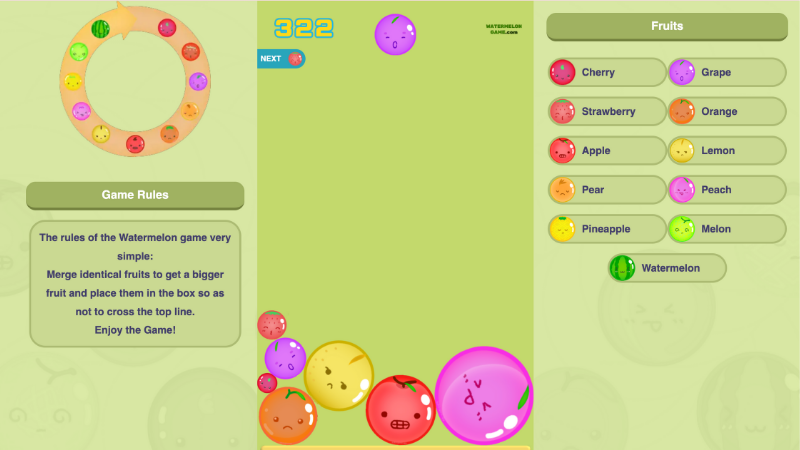
A clear, simple diagram showing the “Game Over” screen of the Watermelon Game. The container is overfilled with sad-faced fruits, and a prominent “Game Over” text is displayed above it with the player’s final score. | Alt Text: The game over screen in the Watermelon Game, showing an overflowing box of fruit and the final score.
Watermelon Game Strategy & Tips for Higher Scores
Ready to move beyond random drops and start aiming for that coveted 3,000-point score? These strategies, ranging from foundational basics to expert-level insights, will help you organize your container, create massive combos, and avoid common pitfalls.
Beginner Strategies
For those just starting, focus on building a stable foundation.
- Keep Your Pile Level: Avoid creating deep holes or tall, unstable towers. A relatively flat surface makes it easier to place fruits where you want them and predict merges.
- Organize by Size: A popular and effective strategy is to arrange fruits in order from largest to smallest across the container. For example, keep your largest fruits (like peaches and pears) in one bottom corner and your smallest fruits (cherries and strawberries) on the other side. This prevents large fruits from blocking potential merges for smaller ones.
- Merge Small Fruits Quickly: Don’t let small fruits like cherries and strawberries pile up. They take up valuable space and can get trapped under larger fruits. Merge them as soon as you can to keep your container clean.
Advanced Tactics
Once you’re comfortable with the basics, you can incorporate the game’s physics to your advantage.
- Predict the Roll: Before dropping a fruit, visualize how it will roll and settle. You can use this to nudge other fruits into place or tuck a small fruit into a tight gap.
- Master the “Squeeze”: Sometimes, you can drop a fruit between a wall and another fruit to “squeeze” it into a tight spot, triggering a merge that wouldn’t happen otherwise.
- Set Up Chain Reactions: Think several moves ahead. Try to arrange fruits so that one merge will cause the resulting larger fruit to immediately fall into place and trigger another merge. For example, place two apples next to each other, with two oranges waiting right above them.
Common Mistakes to Avoid
Many players hit a score ceiling because of a few recurring errors.
- Stacking Large Fruits in the Middle: Placing your biggest fruit in the center creates a “hump” that makes it difficult to get other fruits to touch. It’s much safer to keep large fruits tucked into the bottom corners.
- Ignoring the Next Fruit: Many versions of the game show you which fruit is coming next. Use this information to your advantage. If you know a strawberry is next, prepare a spot for it next to another strawberry.
- Rushing Your Drops: There is no time limit. Take a moment to think before each drop. A single misplaced fruit can ruin a well-organized container.
Expert Secrets
Top-tier players demonstrate a deep understanding of the game’s subtle mechanics.
- Controlled Chaos: Sometimes, a high-impact drop is necessary to disrupt a stuck pile. Dropping a larger fruit from a height can dislodge smaller fruits that are trapped at the bottom. This is a high-risk, high-reward move.
- The “Tower” Build: A high-level technique involves carefully stacking fruits that are next to each other in the evolution cycle (e.g., a cherry on a strawberry, on a grape). This creates a “tower” ready for a combo. Dropping the right fruit (another cherry in this case) can trigger a rapid, multi-level merge.
- Space Management is Key: After hundreds of test runs, a clear pattern emerges: the game is won or lost based on how you manage the top half of the box. Always prioritize keeping the top layer as low and organized as possible to give yourself maximum flexibility.

The Watermelon Game’s viral success has led to its appearance on multiple platforms, each offering a slightly different experience. Whether you prefer to play on a console, your phone, or right here in your browser, there’s a version for you.
Free Browser Version
The easiest way to play is through a free browser-based version. These versions are accessible on nearly any device with an internet connection, including PCs, laptops, tablets, and smartphones. The primary advantage is immediate, hassle-free play with no downloads or installations required. Many, like the one on this site, are also ad-free, providing an uninterrupted and relaxing gameplay experience.
Mobile & Console Versions
The original, official version that sparked the global trend is “Suika Game” on the Nintendo Switch. This version, developed by Aladdin X, is available for purchase on the Nintendo eShop. Following its popularity, numerous similar games have appeared on mobile app stores for both iOS and Android. While these versions capture the core gameplay, they may differ in terms of physics, graphics, and the presence of ads or in-app purchases.
Offline / Local Options
The official Nintendo Switch version can be downloaded and played entirely offline. Some mobile versions may also offer offline play after the initial download. In terms of performance, the console version is often cited as having the most refined and consistent physics, while browser and mobile versions can sometimes vary slightly depending on the device and internet connection.

Benefits of Playing the Watermelon Game
Beyond being a fun and addictive pastime, engaging with puzzle games like the Watermelon Game offers tangible benefits for your mental well-being and cognitive health. Its calm pace and strategic demands provide a gentle workout for the brain.
Cognitive Benefits
Playing puzzle games is an excellent way to keep your mind sharp. The Watermelon Game specifically helps to:
- Improve Spatial Awareness and Planning: You are constantly evaluating space, predicting how objects will interact, and planning several moves ahead. This strengthens your ability to think strategically.
- Enhance Problem-Solving Skills: Each game is a new puzzle. You learn to recognize patterns, adapt to changing circumstances, and make logical decisions under pressure.
- Boost Focus and Concentration: The need to pay close attention to the placement of each fruit helps improve your ability to concentrate on a single task, a skill that is valuable in many areas of life.
Stress Relief & Mindfulness
The gentle, repetitive nature of the gameplay can have a significant calming effect.
- Promotes a “Flow State”: The deep focus required to play well can induce a meditative state of “flow,” where you become fully immersed in the activity. This can be a powerful way to quiet a busy mind and reduce anxiety.
- Provides a Sense of Accomplishment: Successfully creating a large fruit or beating your high score releases dopamine, a neurotransmitter associated with pleasure and satisfaction. This provides a small but meaningful mood boost.
- Low-Pressure Entertainment: With no time limits or intense action, the Watermelon Game serves as a perfect form of relaxation. Many players find that playing for just 10–15 minutes a day is a great way to decompress and take a mental break.
Watermelon Game vs Other Puzzle Games
While the Watermelon Game is often compared to titans like Tetris and 2048, it carves out its own unique niche in the puzzle genre. Its defining feature—real-world physics—creates a gameplay experience that feels both familiar and refreshingly unpredictable.
The key differentiator is how the game pieces interact. In Tetris, blocks lock into a rigid grid. In 2048, tiles slide predictably. In the Watermelon Game, however, fruits roll, tumble, and settle in organic ways. This introduces a layer of delightful chaos that requires players to adapt their strategies on the fly. A perfect drop can be ruined by an unexpected bounce, while a seemingly bad placement can sometimes roll into the perfect position.
This physics-based system also contributes to the game’s high replay value. No two games are ever exactly the same, ensuring that the challenge remains fresh and engaging session after session.
| Game |
Core Mechanics |
Primary Skill Focus |
Pace & Feel |
Key Differentiator |
| Watermelon Game |
Fruit Merging + Physics |
Strategic Planning, Spatial Awareness |
Relaxing, Methodical |
Unpredictable physics create dynamic challenges. |
| 2048 |
Number Merging, Grid-Based |
Logical Deduction, Foresight |
Calm, Calculated |
Purely mathematical and predictable movement. |
| Tetris |
Block Stacking, Line Clearing |
Quick Reflexes, Pattern Recognition |
Fast-Paced, Intense |
Time pressure and rigid, grid-based placement. |
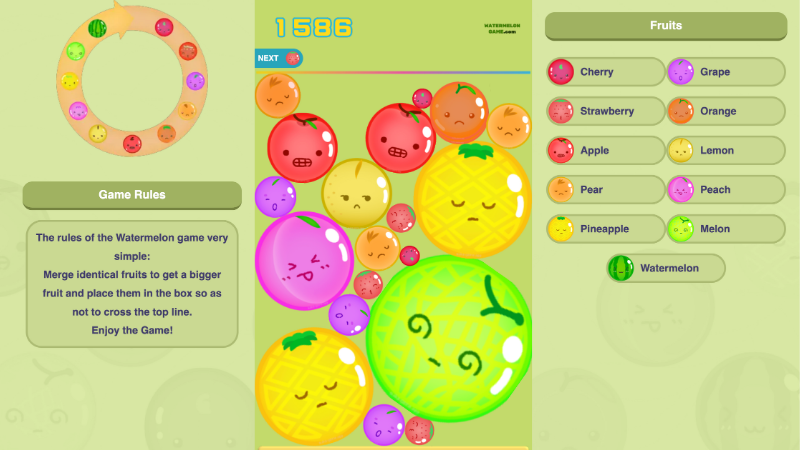
Final Thoughts — Why People Love the Watermelon Game
The Watermelon Game’s appeal lies in its perfect balance of simplicity and strategic depth. It’s a game that anyone can pick up and play in seconds, yet it offers a satisfying challenge that keeps you coming back for “just one more round.” The combination of cute visuals, calming gameplay, and the delightful surprise of its physics engine creates a uniquely relaxing and engaging experience.
It’s more than just a puzzle; it’s a form of digital mindfulness. It rewards patience, encourages thoughtful planning, and provides a genuine sense of accomplishment with every new high score. In a world of fast-paced, high-stress games, the Watermelon Game is a refreshing reminder that sometimes the most enjoyable experiences are the most simple.
We encourage you to take your time, enjoy the process, and share this delightful game with friends and family.
Sources:
- Official Nintendo eShop listing for “Suika Game.”
- Articles and reviews from gaming publications discussing the game’s origins and popularity.
- Academic articles on the cognitive benefits of puzzle games.
About the Author:
This guide was written by a team of casual gaming enthusiasts and content creators with years of experience analyzing puzzle game mechanics and player strategy. We believe in providing clear, helpful, and people-first content that enhances the player experience.
Related Guides:
- The Best Relaxing Puzzle Games for Adults
- A Beginner’s Guide to 2048
- How Mind Games Can Improve Your Focus and Memory

